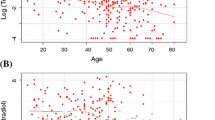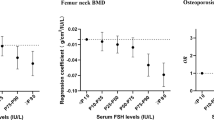Abstract
Summary
The association between follicle-stimulating hormone (FSH) and bone density was tested in 111 postmenopausal women aged 50–64 years. In the multivariable analysis, weight and race were important determinants of bone mineral density. FSH, bioavailable estradiol, and other hormonal variables did not show statistically significant associations with bone density at any site.
Introduction
FSH has been associated with bone density loss in animal models and longitudinal studies of women. Most of these analyses have not considered the effect of weight or race.
Methods
We tested the association between FSH and bone density in younger postmenopausal women, adjusting for patient-related factors. In 111 postmenopausal women aged 50–64 years, areal bone mineral density (BMD) was measured at the lumbar spine, femoral neck, total hip, and distal radius using dual-energy X-ray absorptiometry, and volumetric BMD was measured at the distal radius using peripheral quantitative computed tomography (pQCT). Height, weight, osteoporosis risk factors, and serum hormonal factors were assessed.
Results
FSH inversely correlated with weight, bioavailable estradiol, areal BMD at the lumbar spine and hip, and volumetric BMD at the ultradistal radius. In the multivariable analysis, no hormonal variable showed a statistically significant association with areal BMD at any site. Weight was independently associated with BMD at all central sites (p < 0.001), but not with BMD or pQCT measures at the distal radius. Race was independently associated with areal BMD at all sites (p ≤ 0.008) and with cortical area at the 33% distal radius (p = 0.004).
Conclusions
Correlations between FSH and bioavailable estradiol and BMD did not persist after adjustment for weight and race in younger postmenopausal women. Weight and race were more important determinants of bone density and should be included in analyses of hormonal influences on bone.

Similar content being viewed by others
References
Sun L, Peng Y, Sharrow A, Iqbal J, Zhang Z, Papachristou D, Zaidi S, Zhu L-L, Yaroslavskiy B, Zhou H, Zallone A, Sairam M, Kumar T, Bo W, Braun J, Cardoso-Landa L, Schaffler M, Moonga B, Blair H, Zaidi M (2006) FSH directly regulates bone mass. Cell 125:247–260
Liu S, Cheng Y, Xu W, Bian Z (2010) Protective effects of follicle-stimulating hormone inhibitor on alveolar bone loss resulting from experimental periapical lesions in ovariectomized rats. J Endod 36(4):658–663. doi:S0099-2399(10)00048-8[pii]10.1016/j.joen.2010.01.011
Rendina D, Gianfrancesco F, De Filippo G, Merlotti D, Esposito T, Mingione A, Nuti R, Strazzullo P, Mossetti G, Gennari L (2010) FSHR gene polymorphisms influence bone mineral density and bone turnover in postmenopausal women. Eur J Endocrinol 163(1):165–172. doi:EJE-10-0043[pii]10.1016/j.joen.2010.01.011
Sowers M, Jannausch M, McConnell D, Little R, Greendale GA, Finkelstein JS, Neer RM, Johnston J, Ettinger B (2006) Hormone predictors of bone mineral density changes during the menopausal transition. J Clin Endocrinol Metab 91:1261–1267
Riggs BL, Melton LJ 3rd, Robb R, Camp J, Atkinson EJ, McDaniel L, Amin S, Rouleau P, Khosla S (2008) A population-based assessment of rates of bone loss at multiple skeletal sites: evidence for substantial trabecular bone loss in young adult women and men. J Bone Miner Res 23:205–214
Xu ZR, Wang AH, Wu XP, Zhang H, Sheng ZF, Wu XY, Xie H, Luo XH, Liao EY (2009) Relationship of age-related concentrations of serum FSH and LH with bone mineral density, prevalence of osteoporosis in native Chinese women. Clin Chim Acta 400(1–2):8–13. doi:S0009-8981(08)00480-4[pii]10.1016/j.cca.2008.09.027
Gao J, Tiwari-Pandey R, Samadfam R, Yang Y, Miao D, Karaplis A, Sairam M, Goltzman D (2007) Altered ovarian function affects skeletal homeostasis independent of the action of follicle-stimulating hormone. Endocrinology 148:2613–2621
Drake M, McCready L, Hoey K, Atkinson E, Khosla S (2010) Effects of suppression of follicle stimulating hormone secretion on bone resorption markers in postmenopausal women. J Clin Endocrinol Metab 95(11):5063–5068
Devleta B, Adem B, Senada S (2004) Hypergonadotropic amenorrhea and bone density: new approach to an old problem. J Bone Miner Metab 22:360–364
World Health Organization Study Group. WHO technical report series, no. 843, Geneva 1994. Assessment of fracture risk and its application to screening for postmenopausal osteoporosis, p 129
Engelke K, Adams J, Armbrecht G, Augat P, Bogado C, Bouxsein M, Felsenberg D, Ito M, Prevrhal S, Hans D, Lewiecki E (2008) Clinical use of quantitative computed tomography and peripheral quantitative computed tomography in the management of osteoporosis in adults: the 2007 ISCD Official Positions. J Clin Densitom 11:123–162
Augat P, Fuerst T, Genant H (1998) Quantitative bone mineral assessment at the forearm: a review. Osteoporos Int 8:299–310
Khosla S, Melton L, Atkinson E, O'Fallon W, Klee G, Riggs B (1998) Relationship of serum sex steroid levels and bone turnover markers with bone mineral density in men and women: a key role for bioavailable estrogen. J Clin Endocrinol Metab 83:2266–2274
StataCorp (2005) Stata Statistical Software: Release SE 9.2. College Stations
Bland J, Altman D (1995) Multiple significance tests: the Bonferroni method. BMJ 310:170
Khosla S, Riggs B, Robb R, Camp J, Achenbach S, Oberg A, Rouleau P, Lr M (2005) Relationship of volumetric bone density and structural parameters at different skeletal sites to sex steroid levels in women. J Clin Endocrinol Metab 90:5096–5103
Robbins J, Schott A-M, Azari R, Kronmal R (2006) Body mass index is not a good predictor of bone density: results from WHI, CHS, and EPIDOS. J Clin Densitom 9:329–334
Gracia C, Sammel M, Freeman E, Lin H, Langan E, Kapoor S, Nelson D (2005) Defining menopause status: creation of a new definition to identify the early changes of the menopausal transition. Menopause 12:128–135
Wildner M, Peters A, Raghuvanshi V, Hohnloser J, Siebert U (2003) Superiority of age and weight as variables in predicting osteoporosis in postmenopausal white women. Osteoporos Int 14:950–956
Zhai G, Hart D, Valdes A, Kato B, Richards J, Hakim A, Spector T (2008) Natural history and risk factors for bone loss in postmenopausal Caucasian women: a 15-year follow-up population-based study. Osteoporos Int 19:1211–1217
Koh L, Ben Sedrine W, Torralba T, Kung A, Fujiwara S, Chan S, Huang Q, Rajatanavin R, Tsai K, Park H, Reginster J-Y (2001) A simple tool to identify Asian women at increased risk of osteoporosis. Osteoporos Int 12:699–705
Waugh E, Lam M, Hawker G, McGowan J, Papaioannou A, Cheung A, Hodsman A, Leslie W, Simonoski K, Jamal S (2009) Risk factors for low bone mass in healthy 40–60 year old women: a systematic review of the literature. Osteoporos Int 10:1–21
Macdonald H, New S, Campbell M, Reid D (2005) Influence of weight and weight change on bone loss in perimenopausal and early postmenopausal Scottish women. Osteoporos Int 16:163–171
May H, Murphy S, Khaw K-T (1994) Age-associated bone loss in men and women and its relationship to weight. Age Aging 23:235–240
Harris S, Dallal G, Dawson-Hughes B (1992) Influence of body weight on rates of change in bone density of the spine, hip, and radius in postmenopausal women. Calcif Tissue Int 50:19–23
Forwood M (2001) Mechanical effects on the skeleton: are there clinical implications? Osteoporos Int 12:77–83
Beck T, Petit M, Wu G, LeBoff M, Cauley J, Chen Z (2009) Does obesity really make the femur stronger? BMD, geometry, and fracture incidence in the Women’s Health Initiative-Observational Study. J Bone Miner Res 24:1369–1379
Grodin J, Siiteri P, MacDonald P (1973) Source of estrogen production in postmenopausal women. J Clin Endocrinol Metab 36:207–214
Wu F, Ames R, Evans M, France J, Reid D (2001) Determinants of sex hormone-binding globulin in normal postmenopausal women. Clin Endocrinol (Oxf) 54:81–87
Looker A, Wahner H, Dunn W, Calvo M, Harris T, Heyse S, Johnston C Jr, Lindsay R (1998) Updated data on proximal femur bone mineral levels of US adults. Osteoporos Int 8:468–489
Perneger T (1998) What’s wrong with Bonferroni adjustments. BMJ 316:1236–1238
Acknowledgments
We acknowledge Brent Henderson for his assistance with the data collection and database management and Dan Schiferl of Bone Diagnostic Inc. for his training and supervision of the pQCT analysis. The project described was funded by grants from the National Institute of Arthritis and Musculoskeletal and Skin Diseases (R03AR055734) and National Center for Research Resources (K23RR024685, M01RR00046, and UL1RR025747). The content is solely the responsibility of the authors and does not necessarily reflect the official views of the funding agencies.
Conflicts of interest
None.
Author information
Authors and Affiliations
Corresponding author
Rights and permissions
About this article
Cite this article
Gourlay, M.L., Preisser, J.S., Hammett-Stabler, C.A. et al. Follicle-stimulating hormone and bioavailable estradiol are less important than weight and race in determining bone density in younger postmenopausal women. Osteoporos Int 22, 2699–2708 (2011). https://doi.org/10.1007/s00198-010-1505-x
Received:
Accepted:
Published:
Issue Date:
DOI: https://doi.org/10.1007/s00198-010-1505-x




